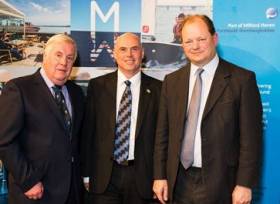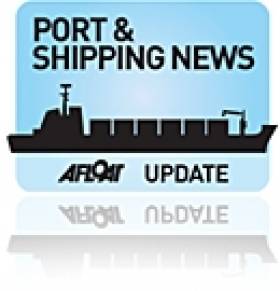Displaying items by tag: Welsh Assembly
#WalesBrexit - The ability of Welsh ports to deliver prosperity for all in a post Brexit UK was highlighted this week to Welsh Government Assembly Members, councillors and key business leaders at a reception held in the Senedd, Cardiff.
Assembly Member for Preseli Pembrokeshire, Paul Davies, hosted the event on Tuesday this week at the National Assembly for Wales. This enabled the Port of Milford Haven, Pembrokeshire County Council and other partners on the Milford Haven Waterway to showcase the vibrant economic cluster that exists around Wales’ largest port.
Attendees heard that, as an island nation with 95% of goods being traded in and out of our ports, it is important for the sector to be prioritised. By ensuring the right conditions are in place to foster new trading relationships and manufacturing-led growth in the future, Wales can strengthen its economy. Attendees were struck by the significance and scale of the supply chain that ports sustain, providing jobs in surrounding communities - a fact that is often overlooked.
The Port of Milford Haven supports 5,000 Welsh jobs and is Wales’ largest port. It is home to five major marine terminals as well as one of Europe’s largest and most efficient power plants. Valero’s refinery accounts for around 10% of Wales’ exports and is worth approximately £55m per annum to the Welsh economy. Combined, the two liquefied natural gas terminals at the port, South Hook LNG and Dragon LNG, are capable of supplying up to 30% of the UK’s natural gas demand.
“With the UK government about to trigger Article 50, now is the time to consider the strengths and opportunities Wales has in its ports,” said Alec Don, Chief Executive at the Port of Milford Haven.
“As a nation bordered on three sides by the sea, we urge the Welsh Government to recognise the value locked in its ports and support us in creating an attractive environment for businesses, large and small, within 'port zones'; an environment which makes it easy to invest, easy to operate and easy to employ.”
“Ports create jobs, drive economic growth, attract investment and create opportunities for all of Wales, not just the immediate communities they serve,” continued Alec. “They are a natural location for logistics, manufacturing and export businesses and are vital arteries of international commerce.”
The reception event unveiled two major projects which the Port of Milford Haven are progressing.
‘Pembroke Dock Marine’ forms part of the Swansea Bay City Deal bid and seeks to create a world class centre for marine energy development, fabrication, testing and deployment at Pembroke Dock, in Pembrokeshire. The Port of Milford Haven has partnered with Marine Energy Wales, ORE Catapult and Wave Hub and is working alongside Swansea University and Pembrokeshire College. Together they are poised to drive innovation and herald the commercialisation of wave and tidal stream technology in Wales which would make a vital contribution to Wales’ blue and green economy; increasing Welsh productivity, export potential and skilled employment opportunities for today and for future generations.
On the other side of the Waterway, in Milford Haven, the ‘Milford Waterfront’ development is well underway. By creating additional all-weather leisure and retail space around its existing vibrant and popular marina, Milford Waterfront is set to unlock tourism opportunities and become one of Pembrokeshire’s hottest new destinations. The successful delivery of this exciting development will create over 600 new jobs and deliver £19m of GVA per annum to the Welsh economy.
Paul Davies, AM for Preseli Pembrokeshire, said: "The Port of Milford Haven is a national asset and a growing centre for the blue and green economy. The businesses along the Haven Waterway have a strong engineering and tourism pedigree, and the two flagship projects - 'Pembroke Dock Marine' and 'Milford Waterfront' - will help secure those vital skills and jobs in the future."
In his closing remarks Alec Don said: “These projects are just two examples of how ports can help position Wales as a world facing nation to secure a bright, more prosperous future for Welsh people.”
New Telecoms Cable to Link-Up with London and Europe
# PORTS & SHIPPING -A specialist cable-laying vessel, Cable Innovator (1995/14,277 tonnes) arrived into Dublin Port yesterday. She is due start work next week on a €12.5m telecoms cable for CeltixConnect between Dublin and Holyhead.
According to a report in The Irish Times (click HERE) CeltixConnect's chief executive Diane Hodnett expected customers to start transmitting traffic on the cable at the end of January.
The cable will pass through the East Point Business Park in Dublin and on to the city's IFSC. On the Welsh side, the 131km cable will connect to the Welsh Assembly-funded Parc Cybi business park in Holyhead. From there it will connect to networks linking Manchester, London and the rest of Europe.
Capacity on the cable will be sold primarily to telecoms firms and ISPs, mobile phone operators and a small number of multinationals in the technology space which have massive bandwidth requirements.
For more information about the UK-flagged vessel which berthed in the port's Alexandra Basin, click this LINK.
Restructured Fastnet Line Reduce Year Round Service to Seasonal Schedule
The discontinued winter sailing schedule for this year is also expected not to be repeated during October 2012-March 2013. Fastnet Line's decision to make the Celtic Sea route into a shoulder season and summer only service follows a similar path taken by Stena Line which withdrew Dun Laoghaire-Holyhead (HSS) sailings in mid-September, for report click here. The central corridor route is due to reopen sometime in April or May 2012.
Cork City and County council and Kerry County council have provided €700,000 to support Fastnet Line and yesterday they announced an additional €150,000 in co-funding for the period of the examinership. In order to stabilise finances the ferry company are to radically reduce passenger capacity of the Julia (see photo) from 1,500 down to 950. This is in line with the capacities of the Julia serving 'night' sailings.
She has a crew predominately from Eastern Europe and Irish and UK deck officers. The Bermuda flagged, Hamilton registered vessel is currently berthed at Ringaskiddy Ferry Terminal, Cork Harbour. At 154m she is the largest ferry to date capable of berthing in the limited confines of the swing basin in Swansea and with a draft of 5.8m in a port which is subject to a large tidal range on the Bristol Channel.
Operating costs on the 10 hour service has been severely hampered by continuing increases to world oil prices. From the year 2010 to this year, fuel costs rose by 27% and almost 50% from the original budget of 2009. The company claims that each crossing amounts to €18,560 alone in fuel costs.
Fastnet Line to date has carried 150,000 customers, of which 75% have originated from the UK market, generating on average €350 per person (€40m approx) exclusive of fare and on-board spend. This crucial market is core to the success of the company's direct 'gateway' route to scenic south-west Ireland, with Swansea connected to the M4 motorway linking midland population centres and London. The operator claims a saving of 600km driving based on a round trip compared to using rival ferries running on routes to Rosslare from Pembroke Dock and Fishguard.
Since the reinstatement of the service in March 2010, after Swansea Cork Ferries pulled the Superferry (photo) off-service in 2006, the loss to tourism generated revenue on both sides of the Celtic Sea was estimated to be £25m per annum according to the Welsh Assembly and a similar figure recorded in the Cork and Kerry region.
The company also outlines the reduction in carbon emissions saved from operating the only direct service specifically connecting the regions of Glamorgan and Munster. Some 500,000 freight miles alone were saved in the Welsh region since the service started instead of using alternative route running from Pembrokeshire ports.
- Cork Harbour
- west cork
- port of Cork
- Celtic sea
- Cork City council
- Fastnet Line
- M.V. Julia
- M4 motorway
- Kerry
- Irish High Court
- Stena Line
- Ports and Shipping News
- cork harbour news
- Ferry news
- HSS
- Welsh Assembly
- Cork County Council
- Associated British Ports
- ABP
- Ringaskiddy Ferry Terminal
- M.V. Superferry
- SwanseaCork Ferries
- SCF
- Fastnet Line Group
- Kerry County Council
- HSS Dun LaoghaireHolyhead sailings
- Glamorgan
- Munster regions
- Bristol Channel
- Bristol Channel tidal range
- Swansea Port
- Irish tourism sector
- Pembroke DockRosslare
- FishguardRosslare
Renewable Energy Firms Plan Tidal Array in Wales
Two renewable energy companies have applied for planning permission to install a tidal turbine array off the Welsh coast.
Energy Efficiency News reports that the 10MW array commissioned by RWE npower renewables would consist of seven SeaGen turbines from UK-based Marine Current Turbines (MCT), enough to generate energy for 10,000 homes.
The windmill-like turbines would be installed 1km off Anglesey in north Wales between Skerries and Carmel Head and be operational by 2015.
SeaGen turbines are already operating in Northern Ireland's Strangford Narrows, an installation accredited by Ofgen as Britain's first tital power plant. MCT is also working with ESB International on a 100MW project off the Antrim coast.
The Welsh Assembly has set a target of capturing 10% of tidal and wave energy off the Welsh coast by 2025 as part of its renewable energy plan.
Energy Efficiency News has more on the story HERE.
































































